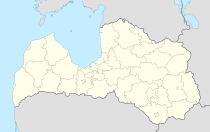Valka
| Valka ( German : Walk) | ||
|---|---|---|
 |
|
|
| Basic data | ||
| State : |
|
|
| Landscape: | Livonia ( Latvian : Vidzeme ) | |
| Administrative district : | Valkas novads | |
| Coordinates : | 57 ° 47 ' N , 26 ° 1' E | |
| Residents : | 5,489 (Jan. 1, 2016) | |
| Area : | 14.3 km² | |
| Population density : | 384 inhabitants per km² | |
| Height : | 61 m | |
| City law: | since 1584 (1922) | |
| Website: | www.valka.lv | |
| Post Code: | ||
| ISO code: | ||
Valka ( German Walk ) is a city in northern Latvia right on the Estonian border. The larger Estonian part of the city is called Valga . In 2016 Valka had 5489 inhabitants.
history
- For the history before 1920: see Walk
Until the independence of the Baltic states after the First World War , the city of Walk was populated by Estonians and Latvians as well as by Russians, Jews and Germans. In the spring of 1919 the Bolsheviks were driven out by the Estonian army, but Latvia also made claims on the city. In an arbitration decision, the present British Commission of the Entente (or Colonel Stephen Tallents ) decided in 1920 to divide the city. Only one district in the southwest was part of Latvia, while the center and the train station were part of Estonia. Over 2500 Latvians have now moved to the Latvian part of the city, where new settlements have been built. In 1922 Valka received city rights.
During the Second World War , heavy fighting took place north of the city on the Embach in 1944 . After the end of the war until 1991, the city limits could be crossed without any formalities. Valka was a district town in the Latvian SSR and was supported by the settlement of industry. People of various origins came to Valka from all over the Soviet Union , including Estonians , whom the lower prices had lured to Latvia. In 1989 the population was 8,200.
With the independence of Latvia and Estonia after the collapse of the Soviet Union in 1991, there was again a state border with customs controls . Valka suddenly found itself in the hinterland and lost its inhabitants due to problems with the economic conversion. By the time the EU expanded in 2004 , more than 100 companies had settled in the city. The main areas of employment are wood and metalworking, light industry and service industries. In 2007 both countries joined the Schengen Agreement , so that today there is freedom of movement and the two sister cities develop many joint activities.
Educational institutions
The old Walk had already been a school town. Here was z. For example, the Livonian community school founded by Jānis Cimze , which taught in Latvian and Estonian.
A branch of the Latvian University has existed here since 2004 . There is also a grammar school, the Latvian-Estonian institute, a primary school, the Jānis-Cimze music school, an art school and several preschools and kindergartens.
Sports
In 1922 the Valka sports club was founded with ten sports departments. In 1938 the association merged with the Border Guard Sports Club and the Alūksne Sports Club.
In the post-war period it was not until 1959 that club activities began again with the “Varpa” sports community. The club's athletes achieved good results at the Latvian SSR level. Today, with the stadium and modern sports halls, there are many opportunities to do sports.
Military cemetery
In Valka there is a German military cemetery with fallen soldiers from the First World War . According to a notice posted on the street, there are also said to be victims from the period from 1941 to 1944.
Valkas novads
Since 2009 the city has formed an administrative community with five surrounding municipalities, a Novads or district (see: Administrative division of Latvia ). On July 1, 2010, 10,513 residents were registered. The district is located in wooded terrain on the Estonian border, which is marked here by the Gauja River .
people
- Voldemārs Irbe (1893–1944), painter
- Teodors Celms (1893–1989), German-Baltic philosopher and university professor
- Pavel Loskutov (* 1969), Estonian long-distance runner
- Aigars Fadejevs (* 1975), walker
- Gatis Smukulis (* 1987), cyclist
- Gints Rācenis (* 1981), pianist
- Arturs Neikšāns (* 1983), chess grandmaster
literature
- Hans Feldmann , Heinz von zur Mühlen (Hrsg.): Baltic historical local dictionary, part 2: Latvia (southern Livland and Courland). Böhlau, Cologne 1990, ISBN 3-412-06889-6 , pp. 676-677.
- Astrīda Iltnere (ed.): Latvijas Pagasti, Enciklopēdija. Preses Nams, Riga 2002, ISBN 9984-00-436-8 .
Individual evidence
- ↑ «Latvijas iedzīvotāju skaits pašvaldībās pagastu dalījumā"
- ↑ List view of the war cemeteries. Volksbund Deutsche Kriegsgräberfürsorge, accessed on May 12, 2014 .
